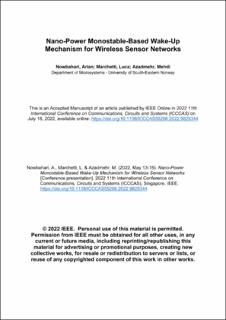Nano-Power Monostable-Based Wake-Up Mechanism for Wireless Sensor Networks
Chapter
Accepted version
Permanent lenke
https://hdl.handle.net/11250/3027249Utgivelsesdato
2022Metadata
Vis full innførselSamlinger
- Institutt for mikrosystemer [546]
- Publikasjoner fra CRIStin [3623]
Originalversjon
Nowbahari, A., Marchetti, L. & Azadmehr, M. (2022, 13.-15. mai). Nano-Power Monostable-Based Wake-Up Mechanism for Wireless Sensor Networks [Paperpresentasjon]. 2022 11th International Conference on Communications, Circuits and Systems (ICCCAS), Singapore. IEEE. https://doi.org/10.1109/ICCCAS55266.2022.9825344Sammendrag
Wireless sensor networks (WSNs) generally consist of thousands of sensor nodes, each one supplied by a battery or harvested energy. To prolong the lifetime of wireless sensor networks, wake-up receivers (WuRxs) are typically employed. WuRxs can selectively activate sensor nodes by decoding a signal called wake-up call (WuC). Therefore, they optimize the power management of WSNs, by allowing communication when requested. In this article, an ultra-low power implementation of a sequential WuRx concept is proposed. The WuRx is composed of AND gates, switches, and monostable circuits. The monostable circuit is implemented through a transistor that generates a pulse according to a simple RC network and a switch. The proposed WuRx decodes the WuC signal by comparing the duty cycle of the received signal with the output signals of the monostable circuits. The ultra-low power implementation is validated at simulation level. The WuRx consumes 32.8nW when decoding a 3-bit wake-up call signal and 153nW when decoding 11 bits.
